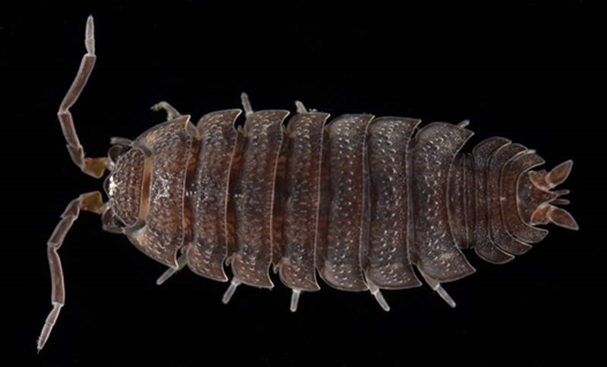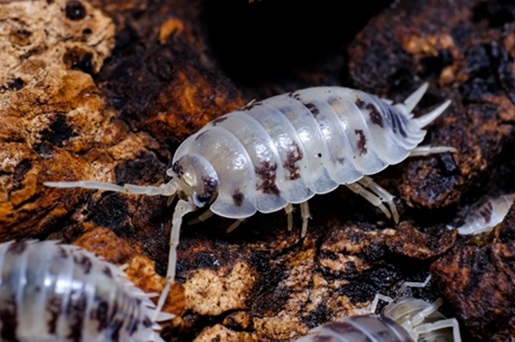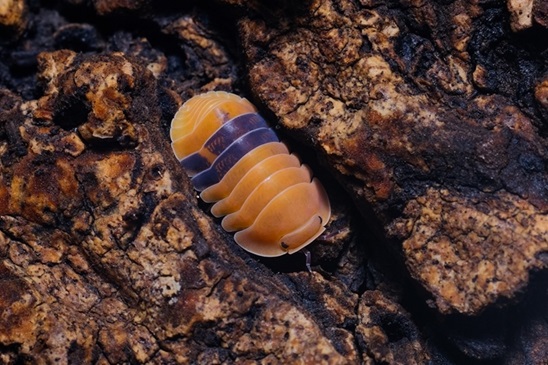Sowbugs & Pillbugs
ENTFACT-439: Sowbugs and Pillbugs (aka Rolly-Pollies) | Download PDF
Olivia Katz, Graduate Research Assistant
Zachary DeVries and Jonathan Larson, Extension Specialists
Fast Facts
- Sowbugs and Pillbugs are isopods, types of crustaceans capable of living on land.
- Both primarily feed on decaying plant matter but can also occasionally become pests when they feed on seedlings, roots, fruits, and vegetables.
- While they can be found indoors, they are harmless to people and pets.
- If frequently found in the home, it may signal a moisture problem or an issue with a sealant, window, or door that allows access.
Identification
Pillbugs (family Armadilidiidae) and sowbugs (family Porcellionidae) are both oval shaped, with bodies that are convex above and flat or hollow underneath, and rarely reach more than ¾ inch (19mm) in length. The head and abdomen are small, but the thorax is larger, composing of seven hardened individual, overlapping plates. These isopods also have seven pairs of legs. They both also have 2 pairs of antennae but the second is reduced and may not be visible.

Sowbugs are distinct in that they have two prominent tail like appendages (uropods) and cannot roll into a ball. Pill bugs on the other hand, can roll up into a ball and have no visible appendages besides antennae. This behavior has earned them the common name “roly-pollies”.

Behavior
Pill bugs and sowbugs are completely harmless and will not bite or sting. Both arthropods are terrestrial crustaceans, and are
heavily reliant on ambient humidity to survive. Pill bug’s rolling into a ball is not only for defense, but to retain water. Due to this need for moisture, isopods are largely nocturnal and live in damp spaces. Outdoors, this includes leaf litter, mulch, and under stones or other decorative items. Unfortunately, this need for moisture may also drive them into crawl spaces, basements, and ground level floors of homes and apartments when searching for water.

Isopods are scavengers and generalists that will feed on fungi, decaying matter, and occasionally plant matter. Their chewing mouthparts tend to only feed on plants if they are tender enough, which can cause damage to seedlings and other young plants.
Life Cycle
Pillbugs and sowbugs typically have a life span of about 3 years. They also display some parental care by carrying eggs and young in their brood pouch (marsupium). They will have about 1-2 broods a year with about two dozen offspring. It takes about 2-3 months for freshly hatched isopods (also known as mancas) to grow into mature adults.
Management
Without high moisture, pillbugs and sowbugs find it almost impossible to survive indoors. Identifying damp places in and around the home that could harbor isopods is key to successful management. Removing leaves, mulch, rotting wood, stones, and flowerpots close to entrances and foundation may greatly reduce unwanted visitors. Also ensuring good drainage around the house’s foundation is key to keeping these areas dry. Pest-proofing doors and windows can also help reduce ease of entry for isopods. Further reading on pest-proofing can be found here.
Indoor insecticide applications are typically of little use as pill bugs and sowbugs will usually die due to lack of moisture indoors. If you find one of these isopods indoors, it is safe to simply pick them up and relocate them outside. Brooms and vacuums are also effective at removing both dead and alive individuals.
Perimeter applications of pyrethroid products on the foundation of the home in spring or fall can limit isopod entry. If insecticides are applied around the home, remove leaf litter to expose insects to treatment. It should be noted that outdoor pesticide applications will unlikely solve recurring problems unless the underlying moisture issues are solved.
Keeping Isopods as Pets

Terrestrial isopods have become popular pets. Many native species can be caught around your home and put into terrariums or vivariums to help break down plant matter. Tropical species have begun to be commonly sold in pet stores as well.

In general, it is important to provide a moisture gradient to allow the isopods to self-regulate. Please always do your research before deciding to get a pet as each species may require different husbandry.
Issued: 10/23
CAUTION! Pesticide recommendations in this publication are registered for use in Kentucky, USA ONLY! The use of some products may not be legal in your state or country. Please check with your local county agent or regulatory official before using any pesticide mentioned in this publication.
Of course, ALWAYS READ AND FOLLOW LABEL DIRECTIONS FOR SAFE USE OF ANY PESTICIDE!
Images: University of Kentucky Entomology
